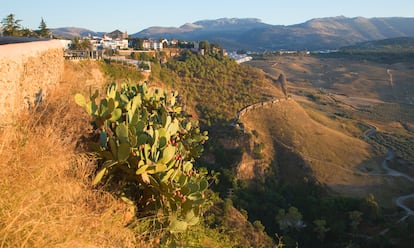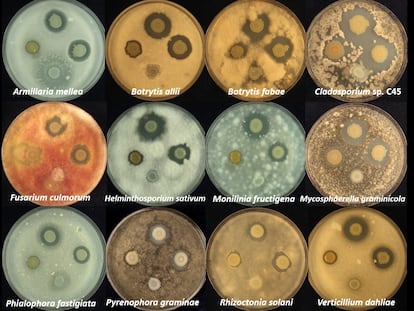Centuries later, the legacy of European colonialism is still alive in the natural landscape
The British, Dutch, Portuguese and Spanish empires standardized the vegetation of regions that were oceans apart and separated by thousands of miles

There are thousands of miles separating the north of Australia, the south of South Africa and eastern Canada. There is also a vast distance between the Mexican Pacific and Spain’s Canary Islands, or between Southeast Asia and Suriname. However, their vegetation is more alike than nature would dictate. It is the still visible trace of European colonialism.
A group of researchers has overlapped the extension and duration of four major empires with the current distribution of thousands of plant species. They have verified that many regions share a landscape decades and even centuries after those empires fell. The British was the one that most modified the environment, and the Dutch the least. In between are Spain (the second most transformative) and Portugal.
In their travels, humans have always carried with them part of the flora of their homeland. Whether for food, aesthetics, nostalgia or simply by accident, the introduction of exotic species that end up adapting to the new environment is a constant in human history. But this transfer grew by a previously unknown scale with the beginning of the era of colonial empires when, starting around 1492, Europeans connected all corners of the planet.
Experts in biological invasions used the most recent information housed in GloNAF, a worldwide database containing the distribution of naturalized plants, to determine their presence in almost 1,200 regions that were once colonies of one or more metropolises. The results were published in the scientific journal Nature Ecology & Evolution.
As expected in empires as large and diverse as the four under study (Spanish, British, Dutch and Portuguese), there is a great heterogeneity of landscapes. The variable that most influences the diversity of the vegetation in any given place is the climate. But researchers soon observed that when comparing different and distant regions belonging to the same empire, some had a greater degree of similarity than would be caused simply by climate, latitude or random chance.
Bernd Lenzner, a botanist at the University of Vienna (Austria) and main author of the study, says that there are a series of explanations for this tendency to uniformity within each empire. “One, which we consider important, is that the British Empire was, on the one hand, very long-lasting, but also very recent.” In effect, in their analysis, they observe that the longer a region belonged to an empire, the greater plant resemblance. Imperial longevity would also explain much of the common landscape in various areas of the former Spanish empire. Some, like various Mexican or Andean ecoregions, belonged to the Spanish crown for 290 years.

The when of each empire also played a role. The Spanish Empire began to extend before the British did, and expansion was conducted chiefly on wooden ships. Britain, on the other hand, expanded through ships and trains with steam engines, which facilitated the connection between the different parts of the British territory. In the 16th and 17th centuries, led by the Spanish, there were hardly any plans for the conscious introduction and naturalization of species from one place to another. It was not until the 18th and 19th centuries, the golden age of the British empire, that botanical gardens and societies became popular, seeking to clone the English countryside in the colonies.
The governing style of each empire was also a relevant factor. “The restrictive trade policies of European empires ensured that plants were predominantly traded between regions occupied by the same power. Therefore, the set of species exchanged between regions was limited to the territory of the empire and, as a result, these areas became more similar in their flora compared to those outside,” notes Lenzner. Both Spain and Portugal, and to a lesser extent Britain, only allowed trade within the empire; everything else was considered contraband. The case of the Dutch empire, the one with the least similarity among its colonies, evidences the opposite connection. The Netherlands maintained more open trade policies, which would have facilitated greater heterogeneity. Even so, there are significant exceptions, such as the commercial introduction of rubber production in Southeast Asia, separated by thousands of kilometers and two oceans from what is now Suriname, the original home of the weeping tree from which natural latex is obtained.
“The restrictive trade policies of European empires ensured that plants were predominantly traded between regions occupied by the same power”Bernd Lenzner, botanist at the University of Vienna and expert in invading species
The research also reveals that the central regions of each empire exhibit greater similarity in their landscapes. In particular, areas with commercial relevance, administrative capitals and major ports show more plant convergence within each empire. This is the case of the coast of the current state of Guerrero, Baja California (Mexico) and Nariño (Colombia). In the British Empire, eastern Australia and India stand out.
In the opposite direction, from the colonies to the metropolis, researchers barely observed significant modifications in the natural landscape of the ancient empires, beyond a few exotic gardens (agricultural species were not included in the study). An exception would be the naturalization of various species of cacti, such as prickly pears, now present in much of Spain and southern Italy. Franz Essl, also from the University of Vienna and a senior author of this research, said that the metropolis often functioned “as a center for the propagation of exotic plants, since in many cases new species were introduced from the colonies first to the mother country, and later they were spread to other regions within the empire.”
Animal invasions, such as rabbits in Australia, have been well documented. But the impact of exotic flora can also be significant. “I agree that notorious cases of species well known to humans, such as rabbits, stand out for their harmful nature. But non-native plants can profoundly alter habitats and ecosystems”, notes Essl. One example is cat’s claw (Carpobrotus edulis). Originally from South Africa, “it was introduced as an ornamental species in Mediterranean regions around the world, where it has become very abundant along the coasts and where it outcompetes specialized native plant species,” he says. Essl also has a special mention for islands. In previous work he and his colleagues showed that more than a quarter of all the islands studied now have more exotic plant species than native ones. Prominent examples are, for example, Hawaii or Mauritius, imagined by many as almost pristine paradises. “There, exotic plant species have strongly transformed island ecosystems,” warns the scientist.
One factor that aggravates the impact of plant colonialism is that plants are at the base of every ecosystem. Another is time. “We knew that alien species can take decades to establish and spread within a region into which they have been introduced, and that this process often takes place with a substantial delay,” he recalls. But he adds: “Detecting such legacies several decades, sometimes even centuries, after the collapse of European empires is something to reckon with. This shows that we need to be very careful and aware of which species we move around the world.”
Tu suscripción se está usando en otro dispositivo
¿Quieres añadir otro usuario a tu suscripción?
Si continúas leyendo en este dispositivo, no se podrá leer en el otro.
FlechaTu suscripción se está usando en otro dispositivo y solo puedes acceder a EL PAÍS desde un dispositivo a la vez.
Si quieres compartir tu cuenta, cambia tu suscripción a la modalidad Premium, así podrás añadir otro usuario. Cada uno accederá con su propia cuenta de email, lo que os permitirá personalizar vuestra experiencia en EL PAÍS.
¿Tienes una suscripción de empresa? Accede aquí para contratar más cuentas.
En el caso de no saber quién está usando tu cuenta, te recomendamos cambiar tu contraseña aquí.
Si decides continuar compartiendo tu cuenta, este mensaje se mostrará en tu dispositivo y en el de la otra persona que está usando tu cuenta de forma indefinida, afectando a tu experiencia de lectura. Puedes consultar aquí los términos y condiciones de la suscripción digital.
More information
Archived In
Últimas noticias
Maduro counterattacks Trump with rhetoric and announces downing of nine drug trafficking aircraft
‘Ecce Homo’: The miraculous disaster that made a small Spanish town famous
Return to sex testing at the Olympics: IOC edges closer to banning transgender women
Trump escalates conflict with Venezuela with the start of covert operations
Most viewed
- Sinaloa Cartel war is taking its toll on Los Chapitos
- Oona Chaplin: ‘I told James Cameron that I was living in a treehouse and starting a permaculture project with a friend’
- Reinhard Genzel, Nobel laureate in physics: ‘One-minute videos will never give you the truth’
- Why the price of coffee has skyrocketed: from Brazilian plantations to specialty coffee houses
- Silver prices are going crazy: This is what’s fueling the rally











































